The Resize Technique – An Easy Method to Find Out If You Can See Diamond Flaws And Blemishes In Real Life
In an ideal world, you might expect expensive products like diamonds to free from flaws and imperfections. However, reality is far from that.
You see, diamonds are created under chaotic conditions deep underground and they undergo an extremely turbulent journey before reaching the Earth’s surface. This is why inclusions are found in a vast majority of mined rough and polished diamonds.
So, unless you are willing to fork out the huge premiums on internally flawless diamonds, chances are, you will be making a selection from diamonds with some flaws and/or blemishes in them.
Now, here’s the million dollar question: Where do you draw the line between “excessively clean” diamonds that may cost hundreds or even thousands of dollars more and “eyeclean” diamonds that offer the best value for money?
A Reality Check – Eyeclean And What It Means
In the industry, “eye clean” is a lingo used to describe diamonds without inclusions visible to the naked eye. However, the problem with “eye clean” is that it isn’t a scientific term and its definition can vary from person to person (i.e. some vendors use 15” as a working distance while some others use 6-8”).
On top of that, every individual possesses a different level of visual acuity. For example, an older person may not be able to see the same level of details when compared to a younger person with better eyesight.
Based on conversations with readers, one of the biggest concerns with buying diamonds online is the issue of eye cleanliness. In fact, 9 out of 10 consumers I interact with have questions about diamonds being “eye clean” and whether they would be able to detect inclusions with their eyes.
Due to the inconsistencies of factors affecting eye cleanliness, it is easy to get confused (and overwhelmed) during your shopping process. That’s why today, I am going to teach you a method which will enable you to select diamonds with confidence and help you save a load of money in the process.
Using The Resize Technique to Verify Eye Cleanliness
At the end of the day, it doesn’t matter how others define the term “eyeclean”. You or your fiancée are going to be the one who’s wearing the diamond jewelry. What really matters is that the diamond is eye clean to YOU and not someone else.
With this in mind, I created a step by step method called the “Resize Technique” which will help you determine whether a diamond is eyeclean.
Step 1: Inspect and check the diamond using magnified images and videos.

James Allen is one of my favorite places to buy diamonds online. The HD magnified videos of their listings are intuitive to use and offer a wealth of information.

Try it out for yourself and interact with diamonds up close!
Step 2: Identify offensive looking inclusions and make a mental note of their locations.
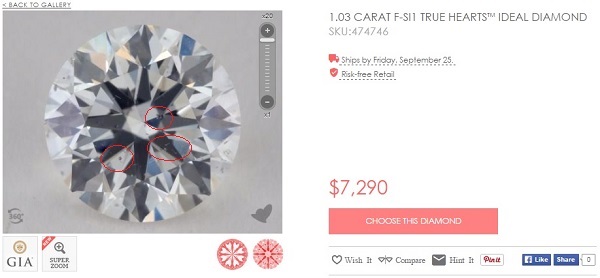
Click here to visit James Allen and try this technique out for yourself.
In general, I keep a lookout for black or colored inclusions like crystals and feathers. I also pay extra attention to inclusions found near the center of the table facet.
Step 3: Find out the diamond’s real life physical size is from the grading report.
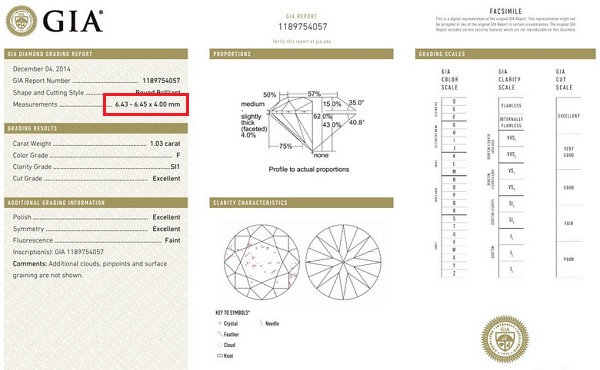
Look for the section listed as “Measurements” to get the diamond’s exact dimensions.
Step 4: Manipulate the zoom feature on your computer and set the image/video to real-life size.
At James Allen, you can make use of the slider to adjust the size of the video instantaneously.
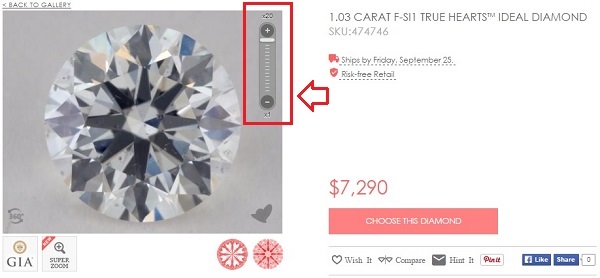
Pick up a ruler and hold it against the screen to make sure you get a realistic face up size. In this example, I resized the video to show a diamond with a diameter of about 6.4mm on my computer screen. This is how big the diamond will look like in real life.
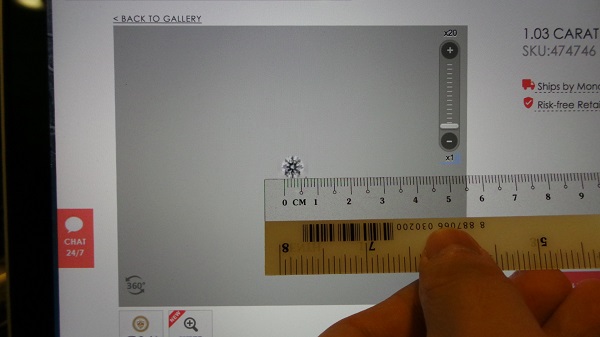
Keep fine tuning the zoom until you get the right size!
Alternatively, if you only have a static image provided by another vendor, you can use free tools like Microsoft Paint or even Microsoft Powerpoint to scale down the photographs.
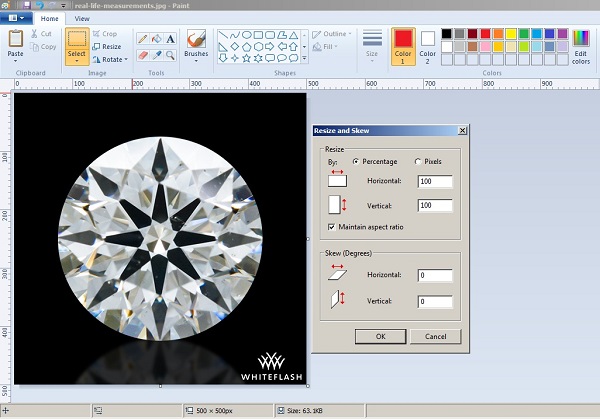
Resizing images MS Paint takes less than a minute.
In this example, I screenshot the magnified image from a White Flash listing and pasted it into Paint. With a little trial and error, you can scale the photograph down to its actual sizing.
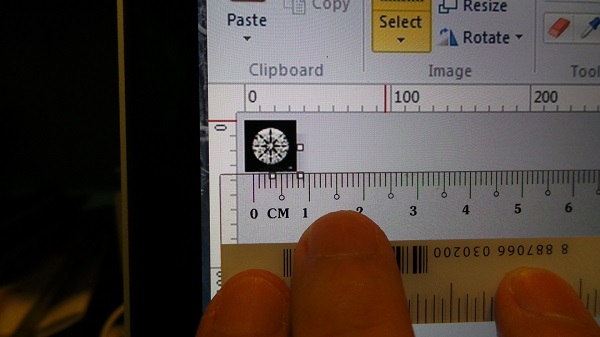
Step 5: With the realistic size of the diamond on your screen, check to see if you can see the inclusions now. You can also drag the video to and fro to change viewing angles. Remember to focus your attention on those inclusions highlighted earlier.
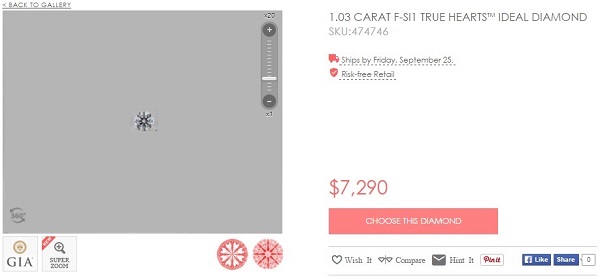
Spend as much time as you need to scrutinize the diamond.
Step 6: If the diamond passes your visual inspection with the Resize Technique, it is very likely to be eyeclean by your own standards. If it fails the test, dump the stone and keep looking!
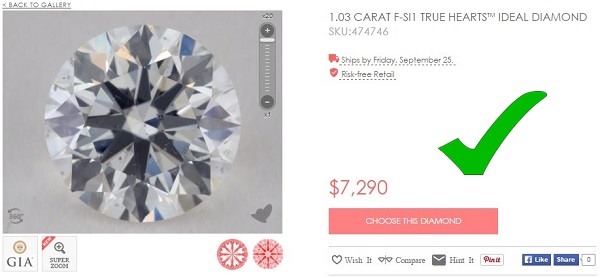
Inclusions Looks Worse Than They Really Are Under Magnification
At this point, I want to highlight a common mistake people make when analyzing magnified photographs. I know many people pass on eyeclean diamonds with blown-up inclusions that look scary and super messy.
It’s a shame to miss out on an awesome diamond if you allow paranoia to cloud your judgement. Here’s a reality check to put things in perspective…
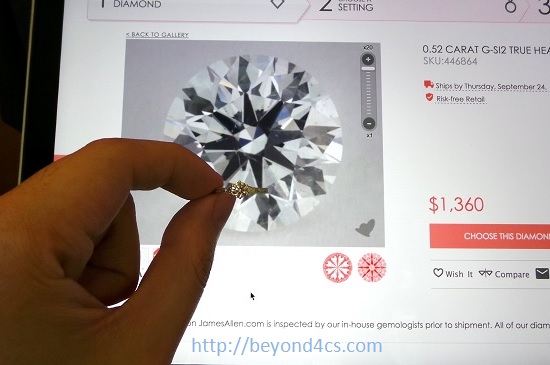
Notice how small the 0.50 carat diamond ring looks in comparison to what you see on the computer screen? In real life, the inclusions are many times smaller than they are under a 10X loupe. The truth of the matter is, most inclusions in VS2s and SI1s in smaller sized diamonds cannot be readily seen with the unaided eye.
What Are The Best Kind of Diamonds to Buy?
I recommend staying within the VS2 and SI1 clarity grades in order to maximize the biggest bang for your buck. In general, I would look for diamonds with well spread out inclusions or those that are colorless/whitish in nature.
Click here to see more examples of eyeclean diamonds…
In GIA or AGS graded VS2 and SI1 diamonds that are less than a carat in size, the majority of flaws and blemishes won’t affect the visual performance of the stone in a negative way. On the other hand, when you are dealing with SI2 diamonds (or SI1 stones with large carat sizes; > 1 carat), you need to exercise caution.
This is because the majority of such diamonds aren’t eyeclean. And when you are in doubt, always double check and seek clarification from the vendor; keeping in mind that whatever definitions they have for eyecleanliness may be different from yours.
Which Types of Diamond Inclusions Are The Worst?
I need to reiterate that I’m a practical person when it comes to diamond shopping. It’s perfectly OK to have imperfections and blemishes as long as the flaws do not interfere with the diamond’s sparkle. And believe it or not, inclusions can actually be useful features to have for identification purposes.
The most “problematic” inclusions are usually found smack in the middle of the diamond. Because of how our eyes and brain work, this is an area where our attention tends to be focused on. As a result, inclusions in this area are easiest to detect and can often result in unpleasant sights.
Click here for more examples of diamonds to avoid…
Recommended Vendors With Videos And Photographs
Hopefully this article has offered you insights to resolving a common problem faced by online diamond shoppers. The bottom line is, you should never consider buying diamonds based on a grading report alone.
If you are looking to buy from a vendor who can’t provide any additional details beyond a grading report, ask yourself the following question: “Why would you choose to work with the vendor when there are other businesses out there who can provide better services?”
When it comes to providing indepth information of diamond listings, James Allen tops my list of recommended vendors. Their HD video technology is second to none and is crucial in helping you make the best decisions.
If you are looking for ideal cut round diamonds or princess cut diamonds, Brian Gavin and White Flash are 2 awesome vendors to begin your search at.
Lastly, feel free to contact me for help with second opinions or to get answers to any questions you have. Good luck with your diamond purchase!
Related Articles
Leave A Comment

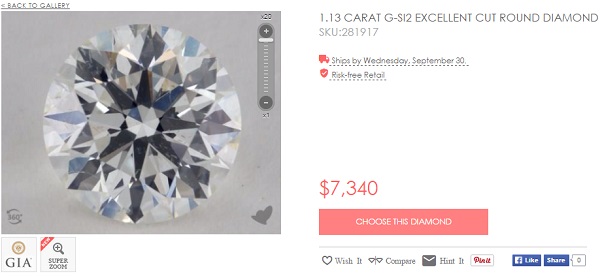
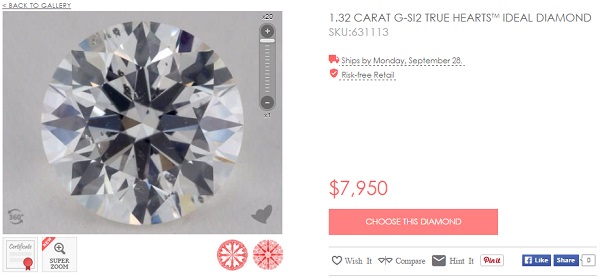
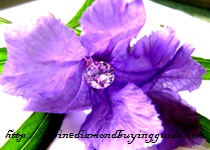
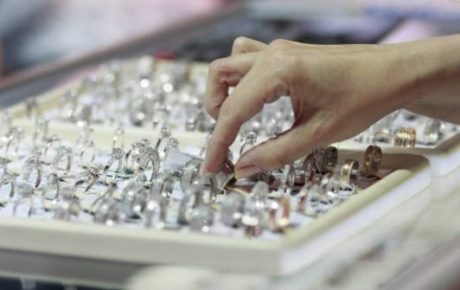
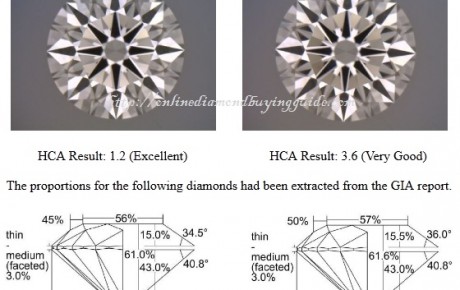
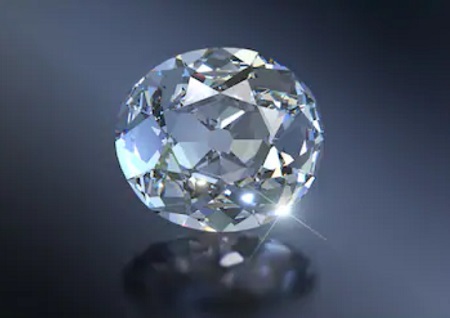









6 Comments
The Resize Technique helped alot and I learnt quite a bit of new stuff today! Thanks for sharing this awesome tip with us. I guess one of the sure fire way to finding eye clean diamonds is to see them in person at a local jewelry store.
Seeing diamonds would definitely help. However, shopping in a brick and mortar store presents lots of limitations by itself. i.e. you get way lesser options to choose from and most jewelers don’t hold ideal cut diamonds in stock.
The other problem with buying in-store is that most jewelers use high powered halogen spotlights to enhance the appearance of the ring. With strong spotlighting environments, the sparkle generated by the stone masks the inclusions when you view it in store.
Once you take the stone out into more neutral environments (i.e. office fluorescent lights or soft lighting), that’s when you may notice inclusions that you would have otherwise miss in store. If you intend to shop locally, make sure you get to inspect the stone away from the spot lighting.
You mentioned that SI1 diamonds below 1 carat sizes are generally eyeclean. Are there any inclusions or comments in the GIA report that you would specifically avoid?
Yes, there are. When an slightly included diamond plot looks too clean to be believable, that’s when you raise red flags.
For many beginners and first timers, they think they found a great diamond and celebrate about how lucky they get. That’s a very dangerous notion. You see, GIA assigns a specific clarity grade for a reason and as a consumer, you need to know why.
Often, it is easy to overlook subtle details that can make BIG differences in appearances when shopping for diamonds.
First and foremost, I am wary of inclusions that can diminish the visual performance of a diamond. Typically, these are extensive cloud and twining wisp inclusions which impede the passage of light through the diamond. More notably, I recommend avoiding diamonds with clarity comments like these: “Clarity grade is based on clouds that are not shown” or “Clarity grade is based on XXXXXXX not shown”.
Based on my experience, these diamonds often end up looking hazy and milky. Here’s an example of such a diamond that has been negatively impacted by clouds.
https://www.jamesallen.com/loose-diamonds/round-cut/1.01-carat-g-color-si2-clarity-excellent-cut-sku-638900
For more information, visit https://beyond4cs.com/grading/other-comments/
I have a diamond which i feel like is a good choice to buy – it is a 1.5ct Color H – excellent CUT (GIA Grading) and SI2 – According to bluenile’s rep – she told me it is eye clean from 6-8inches.
I also have a photo that they sent me – but i’m not too sure if its eye clean or not – would you be able to assist me?
Sure! Send them to me via email and I’ll help you take a look.